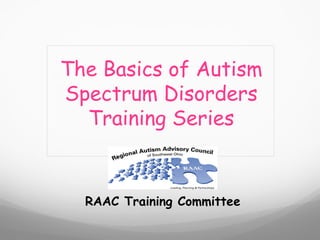
Child care training module seven updated behavior challenges
- 1. The Basics of Autism Spectrum Disorders Training Series RAAC Training Committee
- 2. Child Care Training Series Modules Module One: Autism Defined, Autism Prevalence and Primary Characteristics Module Two: Early Signs of Autism Module Three: Physical Characteristics of Autism Module Four: Cognition and Learning in Autism Module Five: Autism and Sensory Differences Module Six: Communication and Autism
- 3. Child Care Training Series Modules Module Seven: Behavior Challenges and Autism Module Eight: Understanding Behavior in Persons with Autism Module Nine: Functional Behavior Assessment Module Ten: Autism Play Skills to Teach Module Eleven: Safety and Autism
- 4. Behavior Characteristics Children with ASD do not all behave the same way. They have differences based on their communication, social skills, ability to cope, and their environment. The following slides will describe four categories of behavior: Social Interaction Activity Level Repetitive Behaviors Aggression
- 5. Big Idea The goal is not for us to change the child, but to improve their ability to interact with and participate in their world.
- 6. Social Interaction Not Social Overly Social
- 7. Strategies for Social Interaction Some children with ASD do not like it if someone is too close to them. It may be helpful to let the child know that you are approaching them. Some children with ASD like to “people watch,” or be around children, but not have to interact with them.
- 8. Strategies for Social Interaction Some children with ASD do not mind others being nearby, they just ignore them. You may have to explain this to others so that they do not get their feelings hurt Encourage, but do not force the child with ASD to interact.
- 9. Strategies for Social Interaction Be aware of safety concerns for children with ASD. Some children with ASD “never see a stranger.” They talk to or they are over-friendly with children that they don’t know. It can be difficult to teach a child with ASD who is and who is not a “safe” person.
- 10. Activity Level Under-Active Over-Active
- 11. Strategies for Under- Activity It is important to help the child establish an exercise routine: Lack of exercise may result in weight gain. Use of a picture schedule may help with an exercise routine. Children with ASD may need motivators to exercise.
- 12. Repetitive Behaviors None Frequent
- 13. Repetitive Behaviors Explained Children with ASD may have certain behaviors that they do over and over again. Often these are physical behaviors, such as hand flapping, rocking, finger flicking, or a repeated sound or they may including lining up objects. These behaviors may happen because of a sensory need (see Module Five). These repetitive behaviors may occur more often when the child is upset, anxious, or when they are not busy.
- 14. Strategies for Addressing Repetitive Behaviors Be aware that down or free time often leads to the child engaging in these behaviors. Help the child find things that they can do during down time. There are times that you may want to give the child something else to do that limits their use of the repetitive behavior (i.e. if they flap arms, give them something to carry when they are out in the community).
- 15. Challenging Behavior Challenging behavior can include both physically and verbally aggressive behaviors. None Frequent
- 16. Challenging Behavior May Be the Result Of*…… Difficulty expressing basic wants, needs and feelings. Not knowing how to ask for help or how to get someone’s attention. Appearing to understand directions even when they don’t. We may think they are being uncooperative. Difficulty understanding explanations, reassurance or instructions. *Adapted from Nancy Dalrymple’s Helping Children with Autism Learn to “Behave”
- 17. Challenging Behavior May Be the Result of….. Difficulty understanding social rules or social interaction. Difficulty understanding the viewpoint and motives of others. Need for longer than usual time to process, organize, and retrieve information. Dependence on routines and not coping when events are out of order. Limited number of interests and activities. Sensory overload.
- 18. Challenging Behavior May Be the Result Of… Unusual fears about harmless objects or situations. No fear of real dangers. Lack of sleep. Physical discomfort due to gastrointestinal or other medical problems.
- 19. Strategies for Addressing Challenging Behaviors We must first understand the reason behind the behavior (see Module Eight). It is very important that the child with ASD has a way to communicate so that others can easily understand them. Be sure they understand what you are saying. Just because the child can talk, they still may not be able to understand you. Check out, and rule out, any medical reasons for a behavior ( i.e. heartburn, localized pain).
- 20. More Strategies….. The problem could be something in the environment (sensory) that needs to be changed. Give the child time to follow instructions. New places and things can be hard. Gradually introduce new people, places, and things whenever possible.
- 21. Even More Strategies…. Change is very hard. Prepare the child for change. Practice change. It helps to break a task into small steps. Teach new skills or new things in many different settings with different people. Be aware of your own behavior and how your mood or behaviors can influence a child with ASD.
- 22. Big Idea We must first understand why a behavior happens before we can change it.
Notas do Editor
- You-tube video